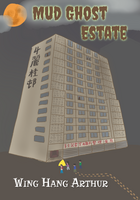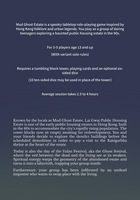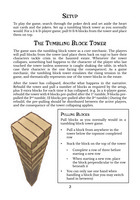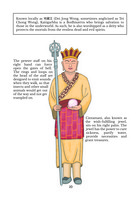Release of Mud Ghost Estate




Mud Ghost Estate is my entry for Folklore Jam 2024.
For the research of the game jam, I looked into the folklore and urban legends of Hong Kong. I came across two elements that form the basis of the game's theme.
- A lot of Hong Kong folklore has something to do with the city's urban development or the three years and eight months Japanese occupation during WWII.
- There are quite a few folk tales surrounding Sau Mau Ping Estate, a public housing estate that is tied to Hong Kong's urban development. There is also record of a cemetery near Sau Mau Ping, which might or might not have been used as a WWII-era mass grave.
This gave me the idea of delving into Hong Kong's urban development and history through the narrative of characters exploring a haunted public housing estate.
Development of the Mechanics
Pretty early on in the design process, I had decided to use a Dread-inspired tumbling block tower (e.g. Jenga) mechanic. Not only that it is a great mechanic for a spooky/horror game, the tumbling block tower thematically represents one of the residential tower blocks of the housing estate.
The initial story idea involved subtler supernatural elements; the characters are urban explorers delving into an abandoned housing estate to search for a shrine dedicated to Kṣitigarbha, witnessing spooky elements that shouldn't have been there (but nothing outright supernatural). After they reach the shrine, the building is going to shake violently (perhaps an early demolition, a landslide, or the act of vengeful souls). The rubbles closes off the characters' way of entry and they have to find another way out before the building collapses altogether.
I like the original plot, but it requires a very slow build up of tension that is more suited to a movie or a video game. That very slow tension works for a solo game like The Wretched (another inspiration for Mud Ghost Estate's mechanics), but I want Mud Ghost Estate to work well as a multiplayer game. Therefore, I amped up the supernatural elements of the story, and the housing estate is no longer abandoned but it is inhabited by the undead in a ghostly carnival.
I love using the player cards as a TTRPG mechanic, as it is something everyone can get easily and possibly already have in their home. I used 39 cards (3 out of 4 suits) as prompts for the locations/encounters, and the remaining suit of 13 cards for character creation.
The housing estate is more than just apartments; there are shops on the ground floor, playgrounds, a school and a nearby cinema. The 39 locations/encounters draw inspirations from those places and also from memories/echoes of WWII. With the supernatural energy twisting the geometry of the estate and turning it into a labyrinth, the explorers may open an apartment door into a completely different part of the estate.
During character creation, each player draws two and picks one heart suit card to be their character for the game. Each character has a skill that they can use to help their group and an item they can use to help themselves. Then the players establish the bonds between the PCs and why they want to explore the haunted housing estate and find the shrine to Kṣitigarbha. During the interlude, a number of cards equal to the number of players plus a joker is shuffled and dealt out to the players, and the player who gets the joker is secretly revealed to be controlling an undead imposter (there is a small possibility that no one gets the joker). The undead imposter can't get out of the haunted housing estate unless another player character is dead, so they are incentivised to play the tumbling block tower game as selfishly as possible (i.e. play Jenga the way it is intended as a competitive game).
The undead imposter/body snatcher trope is common in a lot of horror stories. They are especially prevalent in Hong Kong horror movies I watched growing up. When I was designing the undead imposter for the game, I was also influenced by the memory parasites from Rick and Morty, The Thing (1982 film) and the Cylons from Battlestar Galactica (2004). The players know that a traitor mechanic is in play, but the characters may not suspect a thing until it is too late.
I wrote 8+1 endings for the game based on whether or not the characters get out alive, if they have an undead imposter within the group, and whether they have a single or multiple casualties. And the extra ending is written for groups who don't want character deaths in the story.
Folklore, Culture & History of Hong Kong
Folklore often reflects a region's culture and history. The game draws inspiration from folklore and urban legends surrounding one of Hong Kong's early public housing estates that was constructed in the 60s and redeveloped in the 90s.
Urbanisation happens as people move from rural areas to cities for opportunities and better quality of life. As a port city, Hong Kong reached a population of 1.6 million at the beginning of 1940s before its occupation by Imperial Japan during WWII. For three years and eight months, citizens lived under military rule, a lot of people were forcibly deported or emigrated out of the city, and many of those who remained faced starvation. The city's population shrank to 600 thousand by the end of the war. In the decades following WWII, Hong Kong experienced a population boom due to an influx of immigrants from the mainland and a high birth rate, reaching twice the pre-war population by the early 1960s. Many people lived in shanty towns with poor fire safety, and a fire can quickly spread between the shacks. Between the 50s and early 60s, over a hundred thousand people lost their homes in shanty town fires. In response, the government built public housing to resettle those who lost their homes, which became a more general public housing project as time went on.
Hong Kong's geography is hilly with steep slopes, and its early development was concentrated around the relatively flat coastal regions surrounding the harbour. The new tower blocks in previously undeveloped hilly regions come with unanticipated problems. In the 1970s, landslides caused by heavy rainfall claimed over a hundred lives in densely populated areas. From the 80s onwards, better knowledge of civil and geotechnical engineering have reduced the risk of landslides in urban areas, and residents can be evacuated ahead of time if a landslide does occur.
The real-life Sau Mau Ping Estate is the inspiration behind the fictional Mud Ghost Estate. The public housing estate was built to accommodate the rising population of Hong Kong in the post-WWII era. It was hit by not one, but two landslides. Many of the old tower blocks in the estate were demolished in the 90s to be redeveloped. There are a lot of folklore and urban legends surrounding Sau Mau Ping Estate. There is record of a cemetery in the area before the estate was built and it might have been used as a mass grave for those who were killed by the Japanese army in WWII. There is an urban legend that those who were killed in the landslides are coming back to haunt the living. In one folk tale, the Kṣitigarbha statue from a small temple came to life to protect a couple of the residential blocks from a landslide. An once-popular cinema in Sau Mau Ping is rumoured to be haunted, with reports of ghost sightings.
Ghosts and Trauma
Why do ghosts exist in stories? Ghosts are made up by the imagination of those who are alive. In East Asian horror stories, those who died tragic deaths would come back as ghosts to haunt the living. (The focus is on how they died and not how they have lived, contrasting undead villains in Western horror who are often evil when they are alive.) Perhaps ghosts are just our past trauma coming back to haunt us. When people live through tragedies that are too great for the mind to comprehend, they make up ghost stories. Perhaps the manifestation of ghosts of WWII is the city's collective survivor's guilt. Even decades after on, the ghosts remain, passing from one generation to the next like epigenetics.
In Mud Ghost Estate, the player characters explore the estate during the Yulan Festival, aka the Ghost Festival, and they are transported into an otherworldly version of the estate inhabited by ghosts and echoes of the past. The hauntings in the estate are therefore a representation of the traumas experienced by the previous generations, who want to entrap or possess the player characters.
Like several of my other games, Mud Ghost Estate is a commentary on generational trauma, and not just the ones that passed down along a family, but also the trauma that affects people who share a cultural identity and the society as a whole.
Arc number
18 was originally going to be an arc number in the game. There are 18 layers in a Jenga tower, players have to go through 18 encounters to escape the estate, the estate has 17+1 tower blocks in the lore, and I was going to draw an 18-story apartment block for the cover. (In the estate that inspired the game, blocks 1-17 and 17a were built around the same time, with blocks 34-41 built shortly afterwards.) Moreover, there are 18 hell realms in Chinese Buddhism.
Then I realised 18 encounters would take way too long, so I reduced it to 14 encounters. I struggled to draw an 18-story apartment block for the cover, so I lowered that to 14 too. I also changed the lore so that there are 13+1 tower blocks in the estate. 14 became the new arc number of the game and it works because it's an unlucky number in Chinese.
Future?
This is not a promise, but some ideas I have for the future of Mud Ghost Estate.
- I am currently working on some typo fixes.
- I might touch up the hair salon drawing to give it some floor tiles and better shading.
- I originally planned to do a bit more on the layout, and to fill up some of the blank spaces with more drawings. I might do some of it if I have extra time.
- The game is designed as an A5 zine, so I might do a print run if people want to buy it. Potentially, I can do another crowdfunding campaign, but I am a bit burnt out from fulfilling my last one.
- If I can find a publisher who is interested, the game can be sold as a boxset with the playing cards, and a tumbling block tower.
Files
Get Mud Ghost Estate
Mud Ghost Estate
A spooky TTRPG inspired by the folklore of Hong Kong
| Status | Released |
| Category | Physical game |
| Author | W.H. Arthur |
| Tags | Folklore, hongkong, Horror, Spooky, storygame, Tabletop role-playing game |
More posts
- Mud Ghost Estate v1.11Nov 11, 2024
Leave a comment
Log in with itch.io to leave a comment.